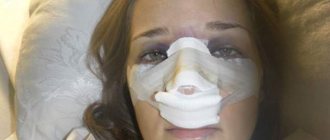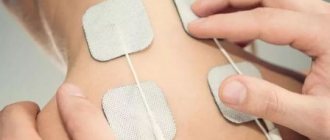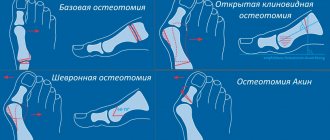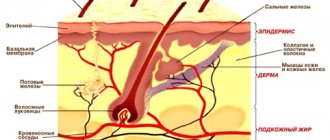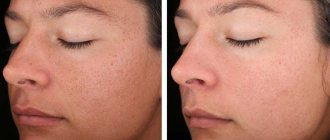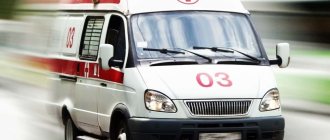Home › Varicose veins › Laser treatment of varicose veins
09/02/2018 · Varicose veins · No comments yet
Conventional surgical procedures have been used to remove blood vessels for many decades. But, with the development of innovative technologies, which include lasers, such operations are carried out with minimal traumatic effect. One such technique is endovenous laser ablation.
The essence of laser treatment for varicose veins
Endovasal laser ablation of leg veins is one of the modern types of medical elimination of the disease. With the introduction of the latest techniques that operate on the basis of the laws of physics, conservative therapy and surgical excision of varicose veins of the lower extremities has become possible for many patients.
The main purpose of endovascular laser coagulation (EVLC), like other low-traumatic methods, is to eliminate:
- Cosmetic defect.
- Symptoms and complaints.
- Lymphovenous stagnation.
- The occurrence of complications in the form of blood clots (varicothrombophlebitis, phlebothrombosis), trophic changes in the dermis, ulcerative lesions, hyperpigmentation, liposclerosis, bleeding from varicose veins.
During laser removal of varicose veins, a light guide is inserted into the narrow vascular lumen. Under its influence, the affected area of the vein is sealed, which, after time, quickly and easily resolves.
Laser removal of varicose veins is a fairly well-known method that does not provoke the development of complications after surgery and does not contribute to the recurrence of the disease. This type of operation is performed without damaging the integrity of the dermis and without the use of anesthesia, is low-traumatic and does not require long-term recovery. The main goal of the operation is to restore physiological blood flow and eliminate aesthetic defects with minimal damage.
Photos before and after
Photos before and after laser leg vein removal
Photos before and after laser leg vein removal
Photos before and after laser removal of facial veins
Photos before and after laser removal of blood vessels on the legs
Photos before and after laser removal of blood vessels on the body
Laser removal of varicose veins on the legs: indications and contraindications
Thermal laser correction of thinned venous walls is recommended in the early stages of varicose veins development. This will allow you to get rid of the disease in the shortest possible time and prevent the development of relapse.
Laser treatment of varicose veins is indicated in the following cases:
- Varicose veins with dysfunction of the trunks of the great or small saphenous veins.
- Pronounced signs of the disease: heaviness, swelling, pain in the legs, deterioration in the patient’s quality of life.
- Trophic disorders of the skin.
- The presence of ulcerative skin lesions.
- Obtaining a negative result when carrying out conservative treatment methods.
Contraindications for laser excision of leg veins are divided into:
- Absolute: predisposition to thrombosis and thrombophlebitis, chronic dysfunction of blood flow and lymph circulation in the lower extremities, significant damage to the walls of the veins.
- Relative: chronic pathologies, dermatological inflammation at the site of varicose veins, pregnancy, lactation, excess weight.
The advisability of endovenous laser coagulation is decided by a phlebologist or vascular surgeon. In addition to the clinical picture of varicose veins, the doctor takes into account the presence of chronic diseases, the general health of the patient and contraindications for laser treatment of leg veins.
The crux of the matter
But first, let's understand what a laser beam is.
A device we call a “laser” converts various types of energy into a very powerful beam of light. The laser has a clearly targeted effect: the doctor can act specifically on damaged areas of blood vessels. During the laser vein treatment procedure, the doctor inserts a light guide into the vessel through a small puncture. The beam heats the walls of the vein, and as a result they stick together. The lumen of the vein closes and it is excluded from the bloodstream. This method is called endovenous laser coagulation (EVLC). Each word in this name is important for understanding the essence of the method: “endovenous” - means the process occurs inside the vessel, “laser” - the method of influence, “coagulation” - translated from Latin means “thickening”, “sticking together”, that is, it describes the process , which occurs with the walls of the vein.
Stages of surgery to remove varicose veins on the legs: price and technology
When varicose veins are diagnosed, surgery is performed using a high-tech innovative laser, monitoring this process using an ultrasound duplex scanner. The specialist sees the direction of the electrode on the monitor and, if necessary, adjusts the course of the manipulation.
Laser treatment is carried out by an angiosurgeon or phlebologist in the office of a medical clinic, observing all the rules of asepsis and antisepsis. The duration of the procedure varies from half an hour to an hour. After surgery, the patient can immediately leave the medical facility.
Laser removal of varicose veins on the legs is carried out in three stages. During the preparatory stage, a full examination and preparation of the skin area at the operation site is carried out.
The main stage is the actual operation itself. Doctors adhere to the following technology:
- The operated area is marked.
- It is treated with disinfectants.
- Local anesthesia is performed.
- The venous vessel is punctured with a special needle.
- A probe with a laser emitter at the end is inserted into the lumen of the vein.
- Obliteration is performed. Laser radiation glues the diseased vessel together.
The final stage includes applying an aseptic dressing to the puncture site. The field is bandaged with an elastic bandage.
The next day after the operation, in order to monitor the correct resorption of blood clots, the attending physician performs a duplex scan. The course of treatment depends on the number of affected areas, their location and the general condition of the vessels and can be carried out five to seven to ten times.
The cost of surgery to remove varicose veins on the legs depends on the scale of the disease and the degree of its development. Also an important factor is the level of classification of the clinic and the attending physician.
Laser vein removal and possible consequences
Today, EVLT is the safest and most effective treatment for varicose veins. Thanks to innovations in vascular surgery, laser vein removal has become the most popular procedure in Europe.
Postoperative period
After the operation, the rehabilitation period begins immediately. The patient is put on a compression bandage and can go home. Of course, he will feel some discomfort in the vein treatment area for some time.
In order to remove such manifestations, the doctor may prescribe Diclofenac, Nimesil and other anti-inflammatory drugs.
Many patients stop using these medications within 2-3 days. As practice has shown, most patients begin work on the second day after laser coagulation.
However, there are simple rules that should be followed in the postoperative period:
- Wear special underwear for 2-3 weeks.
- Walk for 2 hours a day.
- Avoid any physical activity during rehabilitation.
- Avoid any activities using heat.
- Do not drink alcohol.
- Shoes should be comfortable, and for women - without high heels.
Possible consequences and complications of EVLT
One of the important conditions for performing EVLT is that the patient has no contraindications. To eliminate the risk of complications after surgery, the patient must undergo an examination and pass the necessary tests.
After laser intervention, there are practically no complications. Sometimes pigment spots may appear along the operated vein. However, they resolve within 2-6 months without medical intervention.
In very rare cases, patients after laser therapy experience mild inflammation in the area of distant tributaries of the veins. In this case, such complications are eliminated with the help of non-steroidal drugs with anti-inflammatory effects. It is worth noting that if all postoperative rules are followed, such consequences occur very rarely.
Choosing compression garments
After a procedure such as laser vein removal, it is mandatory to wear compression stockings. At the same time, it is important to choose it exactly for you. A phlebologist will help you with this. Choosing special stockings on your own can be harmful to your health.
In order for compression garments to serve you most effectively, it is important to choose the correct size. Otherwise, it will not bring you any benefit, but, on the contrary, will be dangerous to your health. Also, when buying stockings, pay attention to the quality of the product.
How to prevent recurrence of varicose veins
It is worth noting that due to certain habits, as well as hereditary predisposition, varicose veins may recur. Although laser vein removal is a common procedure, it is best to avoid it.
Therefore, every effort must be made to prevent this disease:
- Move as much as possible. At the same time, shoes should be light and comfortable.
- Swimming is the best way to combat vein disease.
- Women are allowed to wear shoes with a heel height of up to 6 cm. On holidays, high heels are allowed.
- Excess weight is a constant burden on the legs, so you should get rid of those extra pounds.
- Expose your feet to contrast dousing more often.
Do not forget to visit a phlebologist at least once every 6 months. This allows the doctor to prescribe preventative treatment for you in a timely manner.
Avoid injuring the skin of the lower extremities. If such a phenomenon occurs, it is necessary to properly treat the wound to prevent the penetration of harmful bacteria.
Subtleties of rehabilitation
The duration of the postoperative period after endovenous laser coagulation is 5–7 days. In order to reliably record the therapeutic effect throughout the entire rehabilitation, it is recommended to strictly follow all medical recommendations and prescriptions.
Immediately after surgery, patients may experience pain in the area of the procedure, minor bruising, discomfort, and a feeling of tension when straightening the limb. Hyperthermia may also develop.
Full recovery occurs within a week. It is possible to speed up the process of restoring the condition of veins and blood vessels by following the following recommendations:
- Eliminate bad habits.
- Take daily walks lasting more than 3 hours.
- Stick to a proper and healthy diet.
- Avoid wearing high-heeled shoes.
- Avoid excessive physical activity.
- Take a course of taking phlebotonics and venotonics.
- Drink vitamin and mineral complexes.
- Do not carry out thermal procedures.
- Limit visits to saunas and hot baths.
Strict adherence to the basic rules of rehabilitation will allow you to quickly recover after surgery and eliminate the development of complications. An important factor during the rehabilitation period is wearing special compression garments, the degree of compression of which is discussed in advance with the attending physician.
Rehabilitation after removal of varicose veins
A huge advantage of laser operations is the absence of mandatory hospitalization. 15-30 minutes of exposure on one leg, the same amount of time on the second (if required), and you can go home. It is advisable to walk so that proper blood flow is restored in the legs and rehabilitation is as calm as possible.
The doctor announces a list of permitted and prohibited points at the consultation stage and will certainly provide a list after all the manipulations have been carried out.
The more accurately the patient follows professional recommendations, the faster the legs will regain their former health.
The mandatory list of prohibitions and permissions will include:
- Hiking. The daily promenade should become a good habit for the patient for quite a long time. For the first 3-4 days, you need to walk for one hour or more, then you need to spend 1.5-2 hours outside every day.
- Excessive loads. Lifting weights is included in the list of prohibitions for the first two days, then you can slowly lift weights up to 10-15 kilograms, but without much fanaticism.
- Same type of work. Working on your feet or sitting in the office all day are equally bad. To provide your legs with the necessary post-operative varied load, you need to plan a sick leave for 7-10 days.
- Sport. After removal of varicose veins, sports should be chosen very carefully. Hiking and swimming are allowed from the second day, but active fitness, exercise equipment, aerobics, gymnastics, and cycling will have to wait about a month. As for stretching exercises, you need to forget about them for a long time: only a doctor will answer when you can start such exercises again.
- Bath and sauna. They are strictly contraindicated after laser surgery on the veins, and for a fairly long period - up to two months.
- Sunbathing. They are not strictly prohibited, but are not recommended due to possible disruption of epidermal pigmentation. Cells after laser treatment are highly susceptible to UV and either hyperpigmentation or hypopigmentation can occur. Solarium is also not allowed during the rehabilitation period!
- Nutrition. There is no need to figure out on your own how to eat after laser vein surgery - a diet will be prescribed by a phlebologist. He will take into account the patient’s weight, actual health data and create an optimal menu. The tasks of nutrition during this period are the rapid restoration of the walls of blood vessels, ensuring the required density of blood flow and boosting immunity. The postoperative diet necessarily includes vegetables and fruits high in vitamin C, seafood, coumarin-rich foods (garlic, lemon, olive oil), nuts, honey, apples, oatmeal, celery, green herbal teas. Red meat, spicy and salty foods, and coffee are briefly banned.
Advantages and disadvantages
Endovasal laser ablation has some advantages over classical removal of venous vessels:
- Speed of the operation.
- Short recovery period.
- Lack of preliminary preparation.
- No hospital bed stay required.
- There are no scars or scars.
- No bleeding occurs.
- Minimal risk of relapse.
- There is no general or spinal anesthesia.
- Trophic changes are not a contraindication for laser treatment.
With competently performed endovasal laser coagulation, the patient does not notice any side effects. Phlebologists recommend limiting trips to the bathhouse, solarium, and beach for seven days after the procedure.
There are also negative aspects of laser treatment. If the diameter of the vein is large, it is impossible to perform surgery using a laser; the skin has to be cut, which subsequently causes scars on the skin.
As a rule, the size of the venous vessel is measured before laser treatment. In this case, phleboectomy is performed. The main disadvantage is the high cost of laser surgery.
Preparing for surgery
If vein treatment is necessary, preparation for surgery begins with a mandatory preliminary consultation. It is carried out by a phlebologist, who, based on the results of the examination and examination data, must answer the following questions:
- level of patency of deep veins;
- current state of the valve apparatus;
- level of blood microcirculation.
It is possible to obtain such information after diagnostics (ultrasound, Doppler sonography).
2 weeks before the intervention, you should stop sunbathing, and remove hair on your legs 5-7 days before the intervention. On the day of the operation, no special preparation is required, no restrictions are prescribed, however, if possible, you should dress in loose clothing made from natural materials to minimize irritation.
Laser treatment of varicose veins on the legs: reviews
- Maria. 23 years old. Varicose veins of the lower extremities, unfortunately, are a chronic disease and therefore another vein may protrude near the treated one. In the postoperative period, it is recommended to wear compression garments for several months. In this regard, the operation should be performed in the autumn-winter period, when wearing hosiery does not cause discomfort.
- Svetlana is 35 years old. I encountered varicose veins in my legs during pregnancy. Initially, the doctor prescribed drug therapy. But, after childbirth, the disease progressed and laser treatment was recommended. I was very pleased with the procedure. The recovery was quick and painless.
- Mikhail is 51 years old. After diagnosing grade 2 varicose veins in the legs, laser coagulation was prescribed. The operation was performed under local anesthesia. After 2 hours, he was released from the clinic to go home. Following all medical recommendations, I returned to a full life within a week.
- Natalya is 39 years old. Varicose veins on the legs were treated with laser. Despite the fact that the operation itself was expensive, I was satisfied with the result. After the procedure, the leg became beautiful and healthy. There are no visible scars or terrible veins on the skin. The efficiency and aesthetics of the operation are worth the money.
Treatment of varicose veins with laser is mainly characterized by positive reviews. Both doctors and patients note the high effectiveness of this technique, its ease of perception and speed of recovery. There may be a slight sensation of pain at the time of insertion of the light guide into the vein and during the day after the operation. However, it is possible to reduce them by taking analgesics as usual.
Rehabilitation activities
You are allowed to leave the clinic immediately after treatment; full recovery takes place at home. Immediately after the operation, you must purchase and wear special compression garments (tights or stockings). The first two days they are worn on a permanent basis, from the third day they are used during the daytime, and taken off at night. In the following days, this underwear will be needed during periods of exercise and walking; this regime will need to be followed for 2.5 - 3 months.
A few days after the operation, you should visit a phlebologist for additional consultation and assessment of the current condition. If necessary, the doctor gives the patient special recommendations. Don’t be afraid to put a lot of stress on your body; bed rest is strictly not recommended; to maintain proper condition, you need to move actively (there are recommendations that you need to walk 5 km a day), while not forgetting to wear compression garments.
Based on website materials: https://clinic-ldf.ru/


